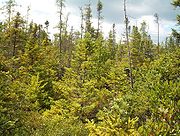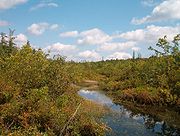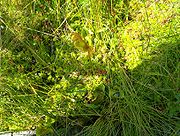
Tannersville Cranberry Bog
Encyclopedia

Sphagnum
Sphagnum is a genus of between 151 and 350 species of mosses commonly called peat moss, due to its prevalence in peat bogs and mires. A distinction is made between sphagnum moss, the live moss growing on top of a peat bog on one hand, and sphagnum peat moss or sphagnum peat on the other, the...
bog
Bog
A bog, quagmire or mire is a wetland that accumulates acidic peat, a deposit of dead plant material—often mosses or, in Arctic climates, lichens....
on the Cranberry Creek in Tannersville, Pennsylvania
Tannersville, Pennsylvania
The village of Tannersville, in Pocono Township, Pennsylvania, is the site of the popular Camelback Water Beach & Ski Area. It is in the Eastern Standard time zone. Elevation is . As of 2000, the population of Tannersville was 2,784....
. It is the southernmost boreal bog east of the Mississippi River
Mississippi River
The Mississippi River is the largest river system in North America. Flowing entirely in the United States, this river rises in western Minnesota and meanders slowly southwards for to the Mississippi River Delta at the Gulf of Mexico. With its many tributaries, the Mississippi's watershed drains...
, containing many black spruce
Black Spruce
Picea mariana is a species of spruce native to northern North America, from Newfoundland west to Alaska, and south to northern New York, Minnesota and central British Columbia...
and tamarack trees at the southern limit of their ranges. Technically, it can be classed as an acid fen
Fen
A fen is a type of wetland fed by mineral-rich surface water or groundwater. Fens are characterised by their water chemistry, which is neutral or alkaline, with relatively high dissolved mineral levels but few other plant nutrients...
, as it receives some groundwater flow. The site was designated a National Natural Landmark
National Natural Landmark
The National Natural Landmark program recognizes and encourages the conservation of outstanding examples of the natural history of the United States. It is the only natural areas program of national scope that identifies and recognizes the best examples of biological and geological features in...
in December 1974. It was purchased by The Nature Conservancy
The Nature Conservancy
The Nature Conservancy is a US charitable environmental organization that works to preserve the plants, animals, and natural communities that represent the diversity of life on Earth by protecting the lands and waters they need to survive....
and the Conservation and Research Foundation in 1956. Like many bogs, its terrain presents an image of solidity, but a liquid mass of decaying peat
Peat
Peat is an accumulation of partially decayed vegetation matter or histosol. Peat forms in wetland bogs, moors, muskegs, pocosins, mires, and peat swamp forests. Peat is harvested as an important source of fuel in certain parts of the world...
lies beneath a six-inch (152 mm) layer of sphagnum and a network of supporting tree roots. However, this bog may be viewed conveniently from a floating walkway.
History

Flora

- SphagnumSphagnumSphagnum is a genus of between 151 and 350 species of mosses commonly called peat moss, due to its prevalence in peat bogs and mires. A distinction is made between sphagnum moss, the live moss growing on top of a peat bog on one hand, and sphagnum peat moss or sphagnum peat on the other, the...
moss - Conifers
- Black spruceBlack SprucePicea mariana is a species of spruce native to northern North America, from Newfoundland west to Alaska, and south to northern New York, Minnesota and central British Columbia...
- Tamarack ("American larch", a deciduous conifer that lends a brilliant yellow hue in autumn)
- Black spruce
- Heath plants
- highbush blueberryBlueberryBlueberries are flowering plants of the genus Vaccinium with dark-blue berries and are perennial...
- leatherleaf
- cranberryCranberryCranberries are a group of evergreen dwarf shrubs or trailing vines in the subgenus Oxycoccus of the genus Vaccinium. In some methods of classification, Oxycoccus is regarded as a genus in its own right...
- sheep laurelKalmiaKalmia is a genus of about 8 species of evergreen shrubs from 0.2–5 m tall, in the family Ericaceae. They are native to North America and Cuba. They grow in acidic soils, with different species in wet acid bog habitats and dry, sandy soils Kalmia is a genus of about 8 species of evergreen shrubs...
- bog-laurelBog-laurelBog-laurel is an evergreen shrub of cold acidic bogs, in the family Ericaceae. It is native to north-eastern North America, from Newfoundland to Hudson Bay southwards....
- swamp azalea
- rhododendronRhododendronRhododendron is a genus of over 1 000 species of woody plants in the heath family, most with showy flowers...
- bog rosemary
- swamp loosestrifeLoosestrifeLoosestrife is the common name of a number of different flowering plants. The species belong to two taxonomic genera, Lythrum, within the family Lythraceae, and Lysimachia, within the family Primulaceae.Lythrum species known as loosestrife include:...
- beggar's tickBidensBidens is a genus of flowering plants in the family Asteraceae. It contains about 200 species. The common names beggarticks, black jack, bur-marigolds, stickseeds, tickseeds and tickseed sunflowers refer to the achene burrs on the seeds of this genus, most of which are barbed...
- highbush blueberry
- Parasitic plants
- dodder (on swamp loosestrife)
- dwarf mistletoeMistletoeMistletoe is the common name for obligate hemi-parasitic plants in several families in the order Santalales. The plants in question grow attached to and within the branches of a tree or shrub.-Mistletoe in the genus Viscum:...
(on black spruce)
- Grasses
- sedges (in more nutrient-rich areas)
- cotton grass
- yellow-eyed grass
- Insectivorous plants
- pitcher plantPitcher plantPitcher plants are carnivorous plants whose prey-trapping mechanism features a deep cavity filled with liquid known as a pitfall trap. It has been widely assumed that the various sorts of pitfall trap evolved from rolled leaves, with selection pressure favouring more deeply cupped leaves over...
- sundewSundewDrosera, commonly known as the sundews, comprise one of the largest genera of carnivorous plants, with at least 194 species. These members of the family Droseraceae lure, capture, and digest insects using stalked mucilaginous glands covering their leaf surface. The insects are used to supplement...
- pitcher plant
- Sun-loving plants (these are giving way to natural succession as heath plants predominate)
- Labrador teaLabrador teaLabrador tea is a name commonly applied to three closely related species:* Rhododendron tomentosum ,...
- golden club (OrontiumOrontiumOrontium is a monotypic genus of flowering plants in the Araceae family. The single species in the genus is Orontium aquaticum. This species is endemic to eastern North America and is found growing in ponds, streams, and shallow lakes. It prefers an acidic environment. The leaves are pointed and...
aquaticum) - hartford fernLygodium palmatumLygodium palmatum is the only species of its genus native to North America. Unlike most species in the genus, this one, called the climbing fern or Hartford fern Lygodium palmatum is the only species of its genus native to North America. Unlike most species in the genus, this one, called the...
(LygodiumLygodiumLygodium is a genus of about 40 species of ferns, native to tropical regions across the world, with a few temperate species in eastern Asia and eastern North America...
palmatum) - Orchids
- grass pinkGrass pinkGrass pinks are a group of terrestrial orchids . The generic name is from Greek and means "beautiful beard", referring to the cluster of hairs adorning the labellum. The genus is mainly confined to the United States, with 5 species found in the southeastern U.S., but only one north into Wisconsin...
- white-fringed orchidEastern Prairie Fringed OrchidPlatanthera leucophaea, commonly known as the Eastern Prairie Fringed Orchid, is a rare species of orchid native to North America. While it is listed as a threatened species in the United States on September 28, 1989, the IUCN does not recognise it as being at risk.P. leucophaea arises from a...
- rose pogoniaPogoniaPogonia is a genus of orchids belonging to the subfamily Vanilloideae. It includes 7 species, and takes its name from the Greek pōgōn and pōgōníās, meaning, respectively, 'beard' and 'bearded.'...
- yellow lady's slipperLady's SlipperLady's slipper orchids, lady slipper orchids or slipper orchids are the orchids in the subfamily Cypripedioidea, which includes the genera Cypripedium, Mexipedium, Paphiopedilum, Phragmipedium and Selenipedium...
- heart-leaf twayblade (not seen in recent years)
- grass pink
- Labrador tea
- wild callaCallaCalla is a genus of flowering plant in the family Araceae, containing the single species Calla palustris...
- gold threadCoptis trifoliaThreeleaf Goldthread or Savoyane is a perennial plant in the genus Coptis, a member of the Ranunculaceae family.It has one small, deeply three-lobed, evergreen leaf rising from the ground....
http://www.nature.org/wherewework/northamerica/states/pennsylvania/preserves/art828.html - winterberryhttp://www.nature.org/wherewework/northamerica/states/pennsylvania/preserves/art828.html
- sumacSumacSumac is any one of approximately 250 species of flowering plants in the genus Rhus and related genera, in the family Anacardiaceae. Sumacs grow in subtropical and temperate regions throughout the world, especially in Africa and North America....
- poison sumacPoison SumacPoison sumac is a woody shrub or small tree growing to 7 m tall. All parts of the plant contain a resin called urushiol that causes skin and mucous membrane irritation to humans...
- poison ivyPoison ivyToxicodendron radicans, better known as poison ivy , is a poisonous North American plant that is well known for its production of urushiol, a clear liquid compound found within the sap of the plant that causes an itching rash in most people who touch it...
- poison sumac
Fauna
- Carnivora
- black bearAmerican black bearThe American black bear is a medium-sized bear native to North America. It is the continent's smallest and most common bear species. Black bears are omnivores, with their diets varying greatly depending on season and location. They typically live in largely forested areas, but do leave forests in...
- bobcatBobcatThe bobcat is a North American mammal of the cat family Felidae, appearing during the Irvingtonian stage of around 1.8 million years ago . With twelve recognized subspecies, it ranges from southern Canada to northern Mexico, including most of the continental United States...
- coyoteCoyoteThe coyote , also known as the American jackal or the prairie wolf, is a species of canine found throughout North and Central America, ranging from Panama in the south, north through Mexico, the United States and Canada...
- gray foxGray FoxThe gray fox is a mammal of the order Carnivora ranging throughout most of the southern half of North America from southern Canada to the northern part of South America...
- minkMinkThere are two living species referred to as "mink": the European Mink and the American Mink. The extinct Sea Mink is related to the American Mink, but was much larger. All three species are dark-colored, semi-aquatic, carnivorous mammals of the family Mustelidae, which also includes the weasels and...
- river otter (Cranberry Creek)
- black bear
- Rodents
- snowshoe hareSnowshoe HareThe Snowshoe Hare , also called the Varying Hare, or Snowshoe Rabbit, is a species of hare found in North America. It has the name "snowshoe" because of the large size of its hind feet and the marks its tail leaves. The animal's feet prevent it from sinking into the snow when it hops and walks...
- beaverBeaverThe beaver is a primarily nocturnal, large, semi-aquatic rodent. Castor includes two extant species, North American Beaver and Eurasian Beaver . Beavers are known for building dams, canals, and lodges . They are the second-largest rodent in the world...
- porcupinePorcupinePorcupines are rodents with a coat of sharp spines, or quills, that defend or camouflage them from predators. They are indigenous to the Americas, southern Asia, and Africa. Porcupines are the third largest of the rodents, behind the capybara and the beaver. Most porcupines are about long, with...
- snowshoe hare
- Breeding birds
- brown creeperBrown Creeper-Description:Adults are brown on the upperparts with light spotting, resembling a piece of tree bark, with white underparts. They have a long thin bill with a slight downward curve and a long tail. The male creeper has a slightly larger bill than the female...
- Nashville warblerNashville WarblerThe Nashville Warbler, Vermivora ruficapilla, is a small songbird in the New World warbler family.They have olive-brown upperparts, a white belly and a yellow throat and breast; they have a white eye ring, no wing bars and a thin pointed bill. Adult males have a grey head with a rusty crown patch ;...
- Canada warblerCanada WarblerThe Canada Warbler is a small 13 cm long songbird of the New World warbler family.These birds have yellow underparts, blue-grey upperparts and pink legs; they also have yellow eye-rings and thin, pointed bills. Adult males have black foreheads and black necklaces...
- wild turkeyWild TurkeyThe Wild Turkey is native to North America and is the heaviest member of the Galliformes. It is the same species as the domestic turkey, which derives from the South Mexican subspecies of wild turkey .Adult wild turkeys have long reddish-yellow to grayish-green...
- barred owlBarred OwlThe Barred Owl is a large typical owl. It goes by many other names, including eight hooter, rain owl, wood owl, and striped owl, but is probably best known as the hoot owl.-Description:...
- brown creeper
- Others
- bog turtleBog turtleThe bog turtle is a semiaquatic turtle endemic to the eastern United States. It was first scientifically described in 1801 after an 18th century survey of Pennsylvania. It is the smallest North American turtle, measuring about long when fully grown...
- pickerelPickerelPickerel may refer to:*Esox, the genus of fish commonly known as the pickerels which includes pike and muskellunge as well as other pickerel*American pickerel*Chain pickerel*Walleye, or Yellow Pickerel * Pickerel Frog...
(Cranberry Creek) - crayfishCrayfishCrayfish, crawfish, or crawdads – members of the superfamilies Astacoidea and Parastacoidea – are freshwater crustaceans resembling small lobsters, to which they are related...
(Cranberry Creek) - bog copper butterfly (LycaenaLycaenaLycaena is a butterfly genus with a world-wide range. It is commonly divided into several subgenera, such as Antipodolycaena. Many formerly independent genera are nowadays subsumed within Lycaena, and the genus Gaiedes may well belong herein too.-Species:Listed alphabetically within groups:The...
epixanthe) (endangered)
- bog turtle
Preservation
The call for preservation of this habitat began with William A. Niering, who as a child visited the bog as the nephew of its owner and was moved ultimately to become a widely recognized authority on bog ecology. The practical benefits of the bog were evident during the Flood of 1955, when bridges downstream of the bog were spared from the massive damage done in much of the PoconosThe Poconos
The Pocono Mountains is a region located in northeastern Pennsylvania, United States. The Poconos, located chiefly in Monroe and Pike counties , are an upland of the larger Allegheny Plateau...
. In 1956 The Nature Conservancy
The Nature Conservancy
The Nature Conservancy is a US charitable environmental organization that works to preserve the plants, animals, and natural communities that represent the diversity of life on Earth by protecting the lands and waters they need to survive....
acquired the first 62.5 acres (252,928.8 m²) for protection. The area held by this organization has increased by gifts and purchases to over 1000 acres (4 km²), and adjoins on additional public lands.
Public visitation
Initially, public visitation to the land was not permitted. However, in the 1980s the Monroe County Conservation District negotiated access to the bog for purposes of public education. A floating boardwalk was constructed and expanded to 1450 feet (442 m) in 1993, which consists of treated lumber supported by floating barrels. Planks are now replaced as needed with a recycled plastic product. Leaving the walkway is definitely not recommended - hikers would sink to the knee or worse in smelly peat, would encounter hazardous poison sumac, and one tour leader who participated in construction of the walkway described movement through the brush as requiring an "army crawl". During spring months all fourth grade public school students in Monroe County are given the opportunity to visit the bog as a field trip. Parents should note that some poison sumac may be within arm's reach of the walkway, and one fourth grader was hospitalized after intentional contact with it. Additionally, groups of visitors are allowed to visit on walks scheduled by the Monroe County Environmental Education Center, 8050 Running Valley Road, Stroudsburg, PA 18360, telephone (570) 629-3061. These walks occur on summer Wednesdays and Sundays, although more occasional winter walks are available. Access may also be granted by special permission of The Nature ConservancyThe Nature Conservancy
The Nature Conservancy is a US charitable environmental organization that works to preserve the plants, animals, and natural communities that represent the diversity of life on Earth by protecting the lands and waters they need to survive....
(Pocono Mountain Office, P.O. Box 55, Long Pond Road, Long Pond, PA 18334, telephone (570) 643-7922). Other trails in the upland woods adjacent to the bog are open to the public without special scheduling.
External links
- The William A. Niering Memorial Page at Connecticut College Arboretum
- The Stuart M. Stein Memorial Preserve at Tannersville Cranberry Bog (The Nature Conservancy)
- The Monroe County Conservation District (Monroe County Environmental Education Center). Note: Much of the information presented here is taken from a MCEEC "bog walk" presentation delivered 9/6/6 and/or a flyer about the bog by John Serrao (1994) distributed by MCEEC.
- Pictures taken from the last guided tour of the 2006 Season (10/22/2006). Pictures courtesy of Anthony Skorochod

